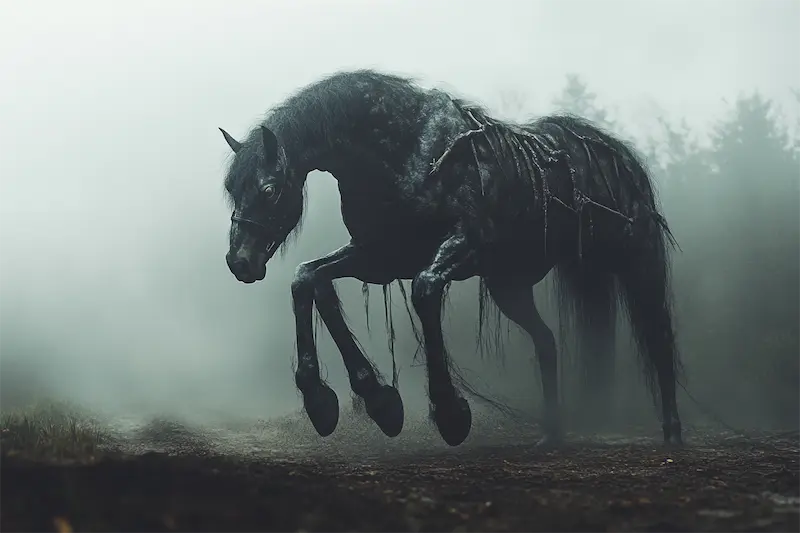- 1 What is Sleipnir?
- 2 Appearance and Characteristics of Sleipnir
- 3 Origin and Symbolic Meaning of Sleipnir
- 4 Morphological Features and Powers of Sleipnir
- 5 Famous Stories and Legends about Sleipnir
- 6 Influence of Sleipnir in Modern Culture
- 7 Similar or Opposing Creatures in Other Mythologies
- 8 Sleipnir in Feng Shui
- 9 Conclusion
What is Sleipnir?
In the rich tapestry of Norse mythology, Sleipnir stands out as a remarkable and enigmatic creature. Known as the eight-legged horse of Odin, the All-Father of the Norse gods, Sleipnir is celebrated for his unparalleled speed, strength, and ability to traverse the various realms of existence. His unique origin and attributes make him a symbol of transcendence, shamanic journeying, and the interconnectedness of the cosmos.
Appearance and Characteristics of Sleipnir
Sleipnir is depicted as a powerful, gray stallion with eight legs, an attribute that sets him apart from all other horses in Norse lore. The additional limbs are not merely a physical anomaly but symbolize his extraordinary abilities. With these eight legs, Sleipnir can gallop faster than any other horse, effortlessly moving through the air, over the sea, and across the land. His name, derived from Old Norse, translates to “the slipper” or “the glider,” reflecting his smooth and swift movement.
Origin and Symbolic Meaning of Sleipnir
Sleipnir’s origin is as fascinating as his abilities. He is the offspring of the trickster god Loki and the stallion Svaðilfari. According to the Prose Edda, during the construction of Asgard’s walls, a giant builder sought to complete the task with the help of his powerful stallion, Svaðilfari. To prevent the builder from finishing on time and claiming his reward, Loki transformed into a mare and lured Svaðilfari away. From this union, Sleipnir was born.
Symbolically, Sleipnir represents the ability to move between worlds. His eight legs are often interpreted as a metaphor for the eight directions or the eight limbs of the cosmos, emphasizing his role as a connector of realms. In shamanic traditions, such a creature embodies the journey between the physical and spiritual worlds, making Sleipnir a powerful symbol of transcendence and spiritual travel.
Morphological Features and Powers of Sleipnir
Sleipnir’s most distinctive feature is his eight legs, which grant him unmatched speed and agility. This unique morphology allows him to:
- Traverse the Nine Realms: Sleipnir can move effortlessly between the different worlds in Norse cosmology, including Asgard, Midgard, and Hel.
- Cross Various Terrains: He can gallop over land, soar through the air, and even glide over water, making him the ultimate mode of transportation for the gods.
- Symbolize Shamanic Journeying: His ability to move between realms aligns with the concept of the shamanic journey, where the practitioner travels between the physical and spiritual worlds.
Famous Stories and Legends about Sleipnir
Odin’s Journey to Hel
One of the most notable tales involving Sleipnir is Odin’s descent into the realm of Hel to seek knowledge about the fate of his son, Baldr. Riding Sleipnir, Odin traverses the treacherous path to the underworld, showcasing the horse’s unparalleled ability to navigate between life and death.
Hermóðr’s Mission
After Baldr’s death, the god Hermóðr rides Sleipnir to Hel in an attempt to negotiate Baldr’s release. Sleipnir’s speed and ability to cross into the realm of the dead are crucial in this mission, emphasizing his role as a bridge between worlds.
The Race with Hrungnir
In another tale, Odin wagers that no horse is faster than Sleipnir. This leads to a race against the giant Hrungnir’s horse, Gullfaxi. Sleipnir wins the race, further cementing his status as the swiftest steed in the cosmos.
Influence of Sleipnir in Modern Culture
Sleipnir’s legacy extends beyond ancient myths into contemporary culture:
- Literature and Art: Sleipnir has inspired various works of literature and art, symbolizing speed, transcendence, and the connection between worlds.
- Popular Media: He appears in modern media, including comics, video games, and films, often depicted as a majestic and powerful creature.
- Cultural Symbols: In Iceland, the glacial canyon Ásbyrgi is believed to be formed by Sleipnir’s hoofprint, showcasing his enduring presence in cultural narratives.
Similar or Opposing Creatures in Other Mythologies
Sleipnir’s role as a divine steed finds parallels in various mythologies:
- Pegasus (Greek Mythology): A winged horse that symbolizes inspiration and the soul’s journey to the heavens.
- Uchchaihshravas (Hindu Mythology): A seven-headed horse that emerged during the churning of the ocean, representing grandeur and divine authority.
These creatures, like Sleipnir, serve as vehicles for gods and symbolize the connection between the mortal and divine realms.
Sleipnir in Feng Shui
While Sleipnir is not a figure in traditional Feng Shui, horses in general are considered symbols of speed, perseverance, and success. Incorporating horse imagery in Feng Shui is believed to bring career advancement and positive energy. Sleipnir, with his extraordinary attributes, could be seen as an embodiment of these qualities, representing swift progress and the overcoming of obstacles.
Conclusion
Sleipnir stands as a testament to the rich symbolism and storytelling of Norse mythology. His unique origin, remarkable abilities, and role as Odin’s trusted steed underscore themes of transformation, transcendence, and the interconnectedness of all realms. Through tales of heroism and divine journeys, Sleipnir continues to captivate the imagination, embodying the enduring power of myth to convey profound truths about the human experience and the cosmos.
